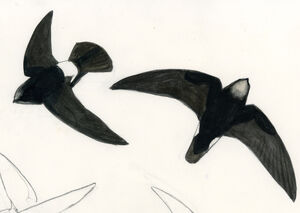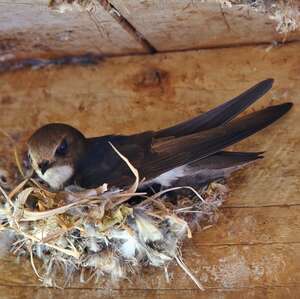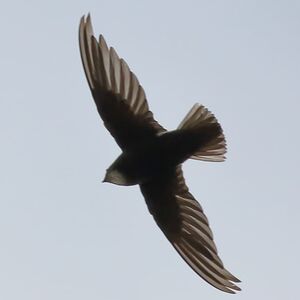Little Swift
Apus affinis - Martinet des maisons
Identification
The Little Swift is a small swift, as indicated by its English name. It belongs to the group of the small swifts with white rump. It is quite easy to differentiate from the others by its square, rather than forked tail (which appears round when fully spread). The white patch of the rump is large and visible on the side. The white patch on the throat is also quite large.
Subspecific information 6 subspecies
- Apus affinis affinis (s Somalia to Mozambique)
- Apus affinis galilejensis (nw Africa to Pakistan, e Sudan to nw Somalia)
- Apus affinis bannermani (Gulf of Guinea islands)
- Apus affinis aerobates (Mauritania to Somalia and south to e South Africa)
- Apus affinis theresae (w and s Angola and s Zambia to South Africa)
- Apus affinis singalensis (s India, Sri Lanka)
Foreign names
- Martinet des maisons,
- Vencejo moro,
- andorinhão-pequeno,
- Haussegler,
- kis sarlósfecske,
- Huisgierzwaluw,
- Rondone indiano,
- stubbstjärtseglare,
- Småseiler,
- dážďovník malý,
- rorýs domovní,
- Lille Sejler,
- pikkukiitäjä,
- Kleinwindswael,
- falciot cuablanc comú,
- Skíðsvölungur,
- jerzyk mały,
- mazā svīre,
- mali hudournik,
- Малый стриж,
- ニシヒメアマツバメ,
- 小雨燕,
- 歐洲小雨燕,
Voice song and call
Habitat
The Little Swift is mainly an African species, highly prevalent south of the Sahara. It is also present in the Maghreb, the Middle East, the Near East and almost all of the Indian Subcontinent. It has been spotted several times in southern Europe. In France, an individual was captured and tagged on May 13th 2001 at Barcaggio, Haute-Corse.
Frequenting mostly open areas, often near towns and villages. Sometimes in gorges, which probably is its primary habitat.
Behaviour character trait
The Little Swift is a gregarious bird that often joins other species. Sometimes large gatherings of several hundred individuals can be seen. It usually hunts high in the sky. Populations living in tropical regions are sedentary, but those in South Africa and the Maghreb are at least partially migratory. The Turkish Little Swifts are completely migratory, though the location of their wintering grounds is unknown.
Flight
Dietfeeding habits
Reproduction nesting
The Little Swift generally reproduces in more or less loose colonies. The nests, made of straw and feathers, without any clearly defined form, are built under an overhang of the roof, on a beam, under a bridge, sometimes even in an old swallow nest which serves as a support.
They are often grouped into a more or less significant mass. The laying is from one to three eggs, depending on the region. Incubation lasts between 22 and 24 days, and the young ones leave the nest after at least 38 days. They are fed by both parents.Threats - protection
IUCN conservation status
concern
in the Wild
threatened
evaluated
The Little Swift experienced a very strong expansion in South Africa at the beginning of the 20th century. At the end of the 19th, only one breeding site was known while 100 years later it occupied the whole country.
Sources of information
- IOC World Bird List (v15.1), Gill, F and D Donsker (Eds). 2025-12-07.
Other sources of interest
 Specification sheet created on
29/07/2023 by Georges Olioso
Specification sheet created on
29/07/2023 by Georges OliosoTranslation by AI Oiseaux.net
© 1996-2025 Oiseaux.net
- Accipitriformes
- Aegotheliformes
- Anseriformes
- Apodiformes
- Apterygiformes
- Bucerotiformes
- Caprimulgiformes
- Cariamiformes
- Casuariiformes
- Charadriiformes
- Ciconiiformes
- Coliiformes
- Columbiformes
- Coraciiformes
- Cuculiformes
- Eurypygiformes
- Falconiformes
- Galliformes
- Gaviiformes
- Gruiformes
- Leptosomiformes
- Mesitornithiformes
- Musophagiformes
- Nyctibiiformes
- Opisthocomiformes
- Otidiformes
- Passeriformes
- Pelecaniformes
- Phaethontiformes
- Phoenicopteriformes
- Piciformes
- Podargiformes
- Podicipediformes
- Procellariiformes
- Psittaciformes
- Pterocliformes
- Rheiformes
- Sphenisciformes
- Steatornithiformes
- Strigiformes
- Struthioniformes
- Suliformes
- Tinamiformes
- Trogoniformes



























